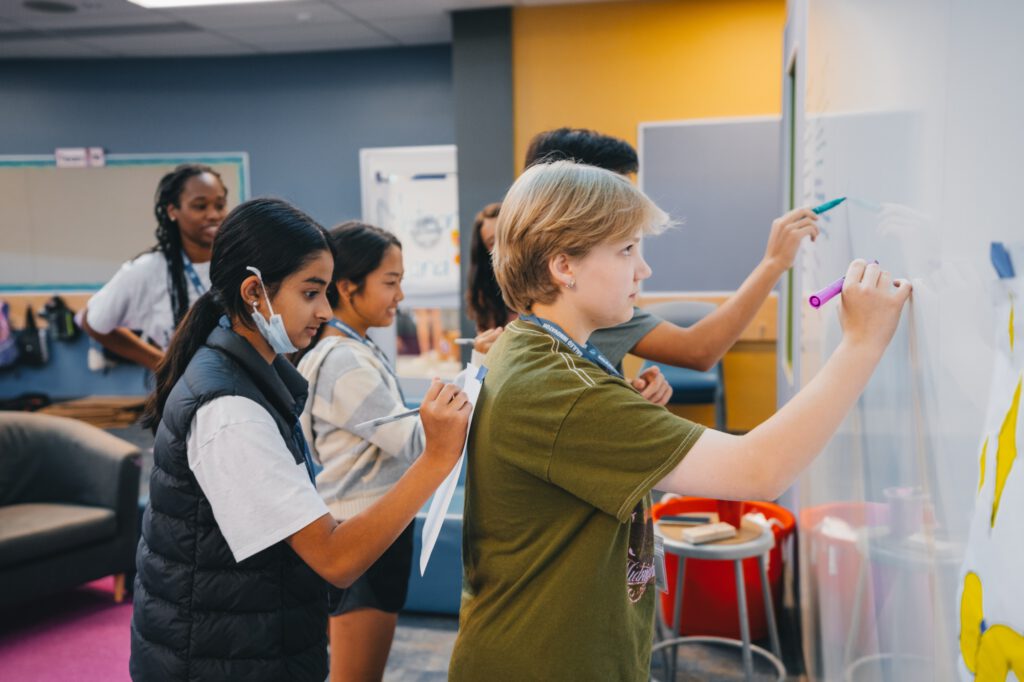For many kids, STEM (science, technology, engineering and math) means exciting hands-on activities, creative engineering challenges and colorful, programmable robots. But to policymakers and leaders of industry, STEM represents the future of innovation. Though STEM programs originated as a reaction to test scores comparing American kids to their international counterparts in an unfavorable light, it has become a proactive means to ensure that kids are prepared for a future where science and technology feature prominently in education, careers and every aspect of daily life.
STEM education is for everyone, regardless of race, socioeconomics or gender, but there are reasons why some programs specifically target girls. Unfortunately, societal bias has led to some inequities throughout the history of STEM programming, and without some remediation, girls will never bridge the gender gap. Generation STEM: A Report from the Girl Scout Research Institute indicates that 74% of girls surveyed are interested in STEM disciplines in middle school, but only 18% of computer science graduates are women. Data suggests girls lose interest or confidence during the high school years. STEM programs and camps for girls create opportunities to maintain that high level of engagement and to provide the skills they will need to participate in a meaningful way in our high tech future.
Why STEM Is So Important
Computing jobs are vital to future growth and innovation in all industries. Job forecast statistics from the U.S. Department of Commerce reveal that over the last decade, employment in STEM occupations has grown faster than that in non-STEM jobs by a factor of 6 to 1. Holding a STEM degree, even if not employed in a STEM occupation, will earn workers 12% more than those holding non-STEM degrees. Unfortunately, though, according to research by Accenture and Girls Who Code, the market share for women in those professions is decreasing. Giving girls access to these well-paying jobs means getting them hooked on STEM early and keeping them interested through high school, then supporting them as they complete their college degrees.
The Importance of Mentors and Models for Girls in STEM
Though women have made tremendous strides in employment, they remain underrepresented in the STEM fields. This is a serious issue of equity as technological advancement continues to increase at an exponential rate, and the gender gap is expected to grow. And while women missing out on professional STEM opportunities is very unfortunate, it is equally distressing that so many girls are losing the excitement and passion they develop for the STEM disciplines as young children.
It is logical then that closing the gap must begin at the earliest possible opportunity when kids are very young:
- Girls need knowledgeable and enthusiastic women to encourage, inspire and mentor them as they complete STEM activities and explore careers. The greatest impact to the gender gap will be realized by supporting girls in elementary and middle school when their love of STEM is still intact.
- In order to dispel gender stereotypes, girls must see scientists, mathematicians and engineers who look like them. Expanding the world’s image of a STEM professional to be more inclusive will benefit all kids.
- Getting girls involved in projects they love and helping them realize success will help to sustain their interest. Providing an opportunity to solve real-world problems in a collaborative context supports them socially, emotionally and academically.
- STEAM programs have all the best aspects of STEM—and an artistic component, as well. Transdisciplinary programs that incorporate art and design may interest more girls.
Ensuring Equity
Camp Galileo is dedicated to growing all types of innovators. Through the Galileo Innovation Approach®, or GIA, staff mentors help campers capture the excitement of STEAM projects and sustain them through the challenges. All Galileo programs are committed to inclusion and diversity, but in recognition that some girls need extra encouragement, there are a few programs designated as “girls only.” These programs seize the opportunity to nurture girls’ tech interests while attempting to eliminate societal bias and narrow the gender gap.
Someday, it will hopefully no longer be necessary to specifically target girls with STEM programs in order to provide extra encouragement and focus on the gender gap. But at present, some girls need a little extra encouragement to see themselves as STEM-competent and believe that STEM careers are for them. Overcoming bias is good for girls and essential for the future of innovation. All kids must have opportunities and receive encouragement to live, learn and grow with technology; it’s a matter of equality.
This is part one of a three-part series on girls in STEM. You can also read about how we can prevent girls from leaving STEM and how summer camp specifically can benefit girls in STEM in a multitude of unique ways.
Enroll your kids in an inclusive STEAM experience at a Galileo camp in your area: San Francisco, Southern California, and Chicagoland. Register for a camp session or sign up for our mailing list to keep up-to-date with camp happenings and innovation resources. Or, for more information about Galileo camps, contact us here.



